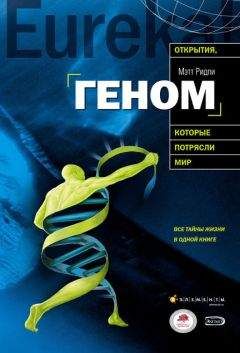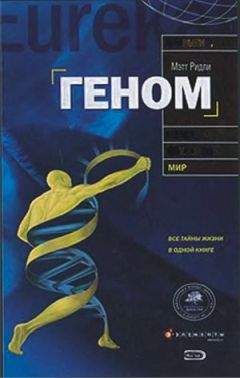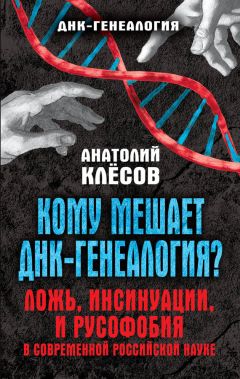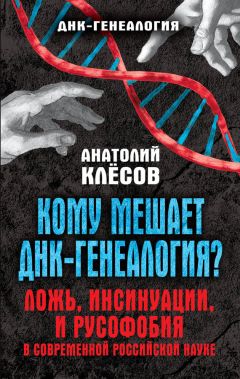Мэтт Ридли - Геном: автобиография вида в 23 главах

Помощь проекту
Геном: автобиография вида в 23 главах читать книгу онлайн
29
Hantington’s Disease Collaborative Research Group. 1993. A novel gene containing a trinucleotide repeat that is expanded and unstable on Hantington’s disease chromosomes. Cell 72: 971–983.
30
Goldberg Y. P. et al. 1996. Cleavage of huntingtin by apopain, a proapoptotic cysteine protease, is modulated by the polyglutamine tract. Nature Genetics 13: 442–449;
DiFiglia M. et al. 1997. Aggregation of huntingtin in neuronal intranuclear inclusions and dystrophic neurites in brain. Science 277: 1990–1993.
31
Kakiuza A. 1998. Protein precipitation: a common etiology in neurodegenerative disorders. Trends in genetics 14: 398–402.
32
Bat O., Kimmel M., Axelrod D. E. 1997. Computer simulation of expansions of DNA triplet repeats in the fragile-X syndrome and Hantington’s disease. Journal of Theoretical Biology 188: 53–67.
33
Schweitzer J. K., Livingston D. M. 1997. Destabilisation of CAG trinucleotide repeat tracts by mismatching repair mutations in yeast. Human Molecular Genetics 6: 349–355.
34
Mangiarini L. 1997. Instability of highly expanded CAG repeats in mice transgenic for the Hantington’s disease mutation. Nature Genetics 15: 197–200.
35
Clong S. S. et al. 1997. Contribution of DNA sequence and CAG size to mutation frequencies of intermediate alleles for Huntington’s disease: evidence from single sperm analysis. Human Molecular Genetics 6: 2820–2825.
36
Wexler N. S. 1992. Mapping fate. University of California Press, Los Angeles.
37
Wexler N. 1992. Clairvoyance and caution: repercussions from the Human Genome Project. In: Kevles D., Hood L. (eds), The code of codes, p. 211–243. Harvard University Press.
38
Wexler N. S. 1992. Mapping fate. University of California Press, Los Angeles.
39
Hamilton G. 1998. Let them eat dirt. New Scientist, 18 July 1998: 26–31;
Rook G. A. W., Stanford J. L. 1998. Give us this day our daily germs. Immunology Today 19: 113–116.
40
Cookson W. 1994. The gene hunters: adventures in the genome jungle. Aurum Press, London.
41
Marsh D. G. 1994. Linkage analysis of IL4 and other chromosome 5q31.1 markers and total serum immunoglobulin E concentrations. Science 264: 1152–1156.
42
Martinez F. D. 1997. Association between genetic polymorphism of the beta-2-adrenoceptor and response to albuterol in children with or without a history of wheezing. Journal of Clinical Investigation 100: 3184–3188.
43
Chorney M. J. et al., 1998. A quantitative trait locus associated with cognitive ability in children. Psychological Science 9: 1–8.
44
Galton F. 1883. Inquiries into human faculty. Macmillan, London.
45
Goddard H. H. 1920. — цит. по кн.: Gould S. J. 1981. The mismeasure of man. Norton, New York.
46
Neisser U. et al. 1996. Intelligence: knowns and unknowns. American Psychologist 51: 77–101.
47
Philpott M. 1996. Genetic determinism. In: Tam H. (ed.), Punishment, excuses and moral development. Averbury, Aldershot.
48
Wright L. 1997. Twins: genes, environment and the mystery of identity. Weidenfeld and Nicolson, London.
49
Scarr S. 1992. Developmental theories for the 1990s: development and individual differences. Child Development 63: 1–19.
50
Daniels M. et al. 1997. Of genes and IQ. In: Devlin B. et al. (eds), Intelligence, genes and success. Copernicus, New York.
51
Herrnstein R. J., Murray C. 1994. The bell curve. The Free Press, New York.
52
Haier R. et al. 1992. Intelligence and changes in regional cerebral glucose metabolic rate following learning. Intelligence 16: 415–426.
53
Gould S. J. 1981. The mismeasure of man. Norton, New York.
54
Furlow F. B. et al. 1997. Fluctuating asymmetry and psychometric intelligence. Proceeding of the Royal Society of London, Series B 264: 823–829.
55
Neisser U. 1997. Rising scores on intelligence tests. American Scientist 85: 440–447.
56
Freeman D. 1983. Margaret Mead and Samoa: the making and unmaking of an anthropological myth. Harvard University Press, Cambridge, MA.
57
Harlow H. F. et al. 1971. From thought to therapy: lessons from primate laboratory. American Scientist 59: 538–549.
58
Pinker S. 1994. The language instinct: the new science of language and mind. Penguin, London.
59
Dale P. S. et al. 1998. Genetic influence on language delay in two-year-old children. Nature Neuroscience 1: 324–328.
60
Paulesu E., Mehler J. 1998. Neuroscience: Right on in sign language. Nature 392: 233–234.
61
Carter R. 1998. Mapping the mind. Weidenfeld and Nicolson, London.
62
Bishop D. V. M. et al. 1995. Genetic basis of specific language impairment: evidence from twin study. Developmental Medicine and Child Neurology 37: 56–71.
63
Fisher S. E. et al. 1998. Localisation of a gene implicated in a severe speech and language disorder. Nature Genetics 18: 168–170.
64
Gopnik M. 1990. Feature-blind grammar and dysphasia. Nature 344: 715.
65
Fletcher P. 1990. Speech and language deficits. Nature 346: 226.
66
Gopnik M. et al. 1996. Genetic language impairment: unruly grammars. In: Runciman W. G., Maynard Smith J., Dunbar R. I. M. (eds), Evolution of social behaviour patterns in primates and man, p. 223–249. Oxford University Press, Oxford;
Gopnik M. (ed.) 1997. The inheritance and innateness of grammars. Oxford University Press, Oxford.
67
Gopnik M., Goad H. 1997. What underlies inflectional error patterns in genetic dysphasia? Journal of Neurolinguistics 10: 109–138;
Gopnik M. 1999. Familial language impairment: more English evidence. Folia Phonetica et Logopedia 51: 5–9.
68
Pinker S. 1994. The language instinct: the new science of language and mind. Penguin, London.
69
Mineka S., Cook M. 1993. Mechanisms involved in the observational conditioning of fear. Journal of Experimental Psychology: General 122: 23–38.
70
Dawkins R. 1986. The blind watchmaker. Longman, Essex.
71
Amos W., Harwood J. 1998. Factors affecting levels of genetic diversity in natural populations. Philosophical Transactions of the Royal Society of London, Series B 353: 177–186.
72
Rice W. R., Holland B. 1997. The enemies within: intergenomic conflict, interlocus contest evolution (ICE), and the intraspecific Red Queen. Behavioral Ecology and Sociobiology 41: 1–10.
73
Majerus M. et al. 1996. Evolution: the four billion year war. Longman, Essex.
74
Swain A. et al. 1998. Dax1 antagonizes Sry action in mammalian sex determination. Nature 391: 761–767.
75
Hamilton W. D. 1967. Extraordinary sex ratios. Science 156: 477–488.
76
Amos W., Harwood J. 1998. Factors affecting levels of genetic diversity in natural populations. Philosophical Transactions of the Royal Society of London, Series B 353: 177–186.
77
Rice W. R. 1992. Sexually antagonistic genes: experimental evidence. Science 256: 1436–1439.
78
Haig D. 1993. Genetic conflicts in human pregnancy. Quarterly Review of Biology 68: 495–531.
79
Holland B., Rice W. R. 1998. Chase-away sexual selection: antagonistic seduction versus resistance. Evolution 52: 1–7.
80
Rice W. R., Holland B. 1997. The enemies within: intergenomic conflict, interlocus contest evolution (ICE), and the intraspecific Red Queen. Behavioral Ecology and Sociobiology 41: 1–10.
81
Hamer D. H. et al. 1993. A linkage between DNA markers on the X chromosome and male sexual orientation. Science 261: 321–327;
Pillard R. C., Weinrich J. D. 1986. Evidence of familiar nature of male homosexuality. Archive of General Psychiatry 43: 808–812.
82
Bailey J. M., Pillard R. C. 1991. A genetic study of male sexual orientation. Archives of General Psychiatry 48: 1089–1096;
Bailey J. M., Pillard R. C. 1995. Genetics of human sexual orientation. Annual Review of Sex Research 6: 126–150.
83
Hamer D. H. et al. 1993. A linkage between DNA markers on the X chromosome and male sexual orientation. Science 261: 321–327.
84
Bailey J. M. et al. A family history study of male sexual orientation: no evidence for X-linked transmission. Behaviour Genetics, in press.
85
Blanchard R. 1997. Birth order and sibling sex ratio in homosexual versus heterosexual males and females. Annual Review of Sex Research 8: 27–67.
86
Blanchard R., Klassen R 1997. H-Y antigen and homosexuality in men. Journal of Theoretical Biology 185: 373–378;
Arthur B. I. et al. 1998. Sexual behaviour in Drosophila is irreversibly programmed during a critical period. Current Biology 8: 1187–1190.
87
Hamilton W. D. 1995. Narrow roads of gene land. Vol. 1. W. H. Freeman, Basingstoke.
88
Пример взят из статьи Susan Blackmore. 1997. The power of the meme meme. Skeptic Vol. 5, № 2, p. 45.
89
Kazazian H. H., Moran J. V. 1998. The impact of L1 retrotransposones on the human genome. Nature Genetics 19: 19–24.
90
Casane D. et al. 1997. Mutation pattern variation among regions of the primate genome. Journal of Molecular Evolution 45: 216–226.
91
Doolittle W. F., Sapienza C. 1980. Selfish genes, the phenotype paradigm and genome evolution. Nature 284: 601–603;
Orgel I. E., Crick F. H. C. 1980. Selfish DNA: the ultimate parasite. Nature 284: 604–607.
92
McClintock B. 1951. Chromosome organisation and genetic expression. Cold Spring Harbor Symposia on Quantitative Biology 16: 13–47.
93
Yoder J. A. et al. 1997. Cytosine methylation and the ecology of intragenomic parasites. Trends in Genetics 13: 335–340.
94
Jeffreys A. J. et al. 1985. Hypervariable ‘minisatellite’ regions in human DNA. Nature 314: 67–73.
95

























